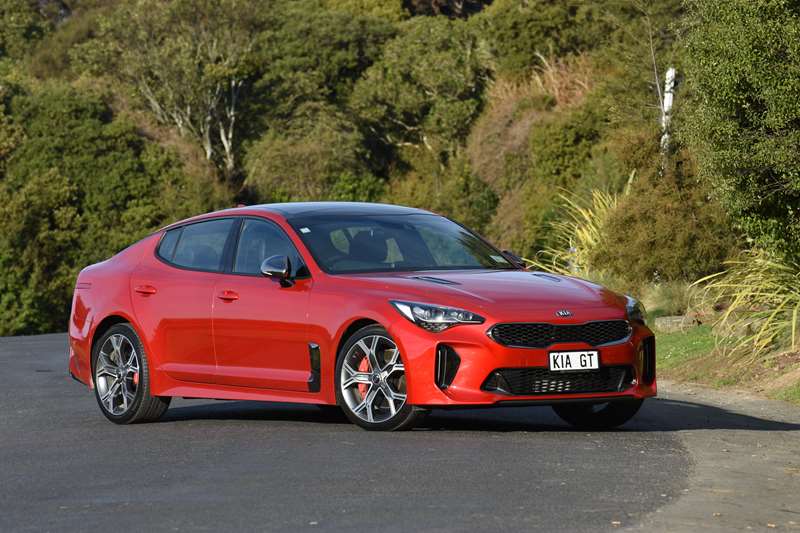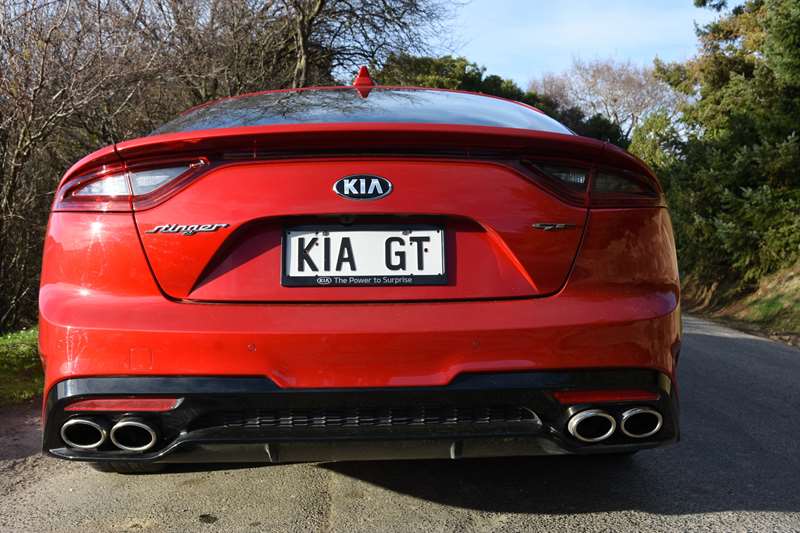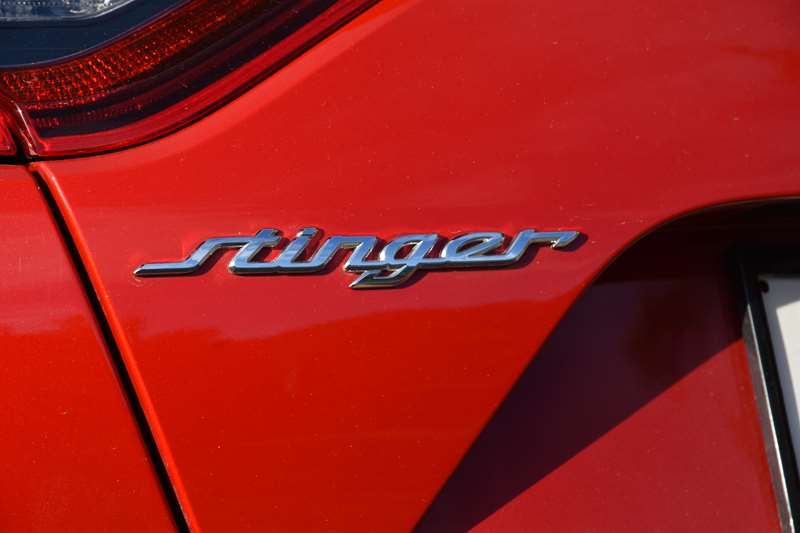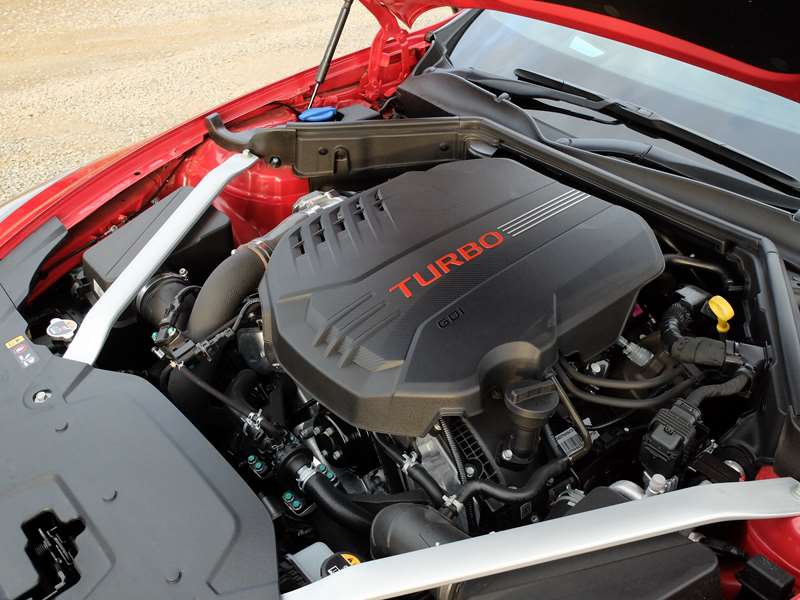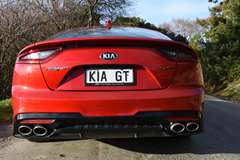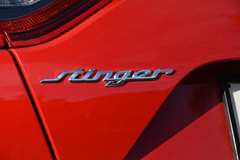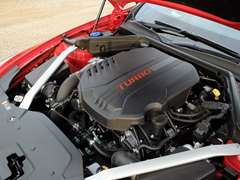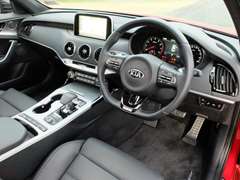| Price: | 69990 |
|---|---|
| Engine: | 3.3-litre twin turbocharged six-cylinder petrol, max power 271kW@6000rpm,max torque 510Nm@1300-4500rpm |
| Transmission: | Eight-speed automatic, rear-wheel-drive |
| Brakes and stability systems: | Front and rear Brembo disc brakes, ABS, EBD, ESP, BAS |
| Safety: | Five-star European NCAP |
| Wheels and tyres: | alloy wheels, 225/40 R19 front and 235/35 R19 rear tyres |
| Fuel and economy: | Premium unleaded petrol, 10.2l/100km, capacity 60 litres |
| Emissions: | 239g CO2/km |
| Dimensions: | Length 4830, width 1870, height 1400 |

What We Like
- Eye-catching
- well-finished
- quick
- and a lot of fun to drive

What We Don't
- Can lose composure on the limit
- relatively tight for space in back seats
Verdict
Every bit the attention-grabbing driver's car Kia would have wanted
Rating:
Overview
In the Stinger, Kia has the attention-grabbing driver's car it wanted, writes David Thomson.
HEADS turned, fingers pointed and animated conversations ensued as Drivesouth put the Kia Stinger through its paces in and around Dunedin last month.
The test car's distinctive plate, KIA GT, might have been in part responsible for the public response, drawing attention to a car whose eye-catching lines don't square with what one expects from a Korean car-maker best known for small cars and family-friendly SUVs.
But the times are a-changing as Kia looks to add flair, panache and a touch of grand touring luxury to its practical, fuss-free reputation.
European influence is writ large: former Audi designers Peter Schreyer and Gregory Guillaume are responsible for the styling, while Albert Biermann, a relatively recent recruit from BMW's M performance division, is in charge of the underlying engineering. And 1000km of testing at Korea's premier race track is dwarfed by the 10,000km covered by prototypes around Germany's famed Nurburgring.
The Stinger is rear-wheel drive, based on a shortened and massively re-engineered version of the platform used by Hyundai (Kia's parent company) for its Genesis saloon.
At first glance, the Stinger looks like a large coupe, but it is actually a fastback four-door saloon.
It is available in three models _ the $54,990 2.0 EX Turbo and $59,990 2.0 GT Line, both powered by a peppy 193kW/353Nm turbo four-cylinder engine, and the flagship $69,990 3.3 GT Sport, as tested, which packs an even more potent 271kW/510Nm 3.3-litre twin turbo V6.
At its best viewed from the front three-quarter angles, the Stinger boasts visual purpose in spades. Its styling has little in common with other Kia models beyond its tiger nose grille. Fittingly, the flagship 3.3 GT is the most purposeful looking of the lot, with Brembo brake calipers nestled within its 19-inch alloys adding an aggressive touch.
The cabin has a premium feel, especially above the waistline, where there is an abundance of soft-touch surfaces and subtle brushed-metal highlighting.
Working from the back, the large power-operated tailgate gives access to a wide and deep but quite shallow boot, which can carry 410 litres of luggage (1141 litres when the rear seats are down).
Inevitably, given the Stinger's coupe-like roofline, head room in the back seats is a little tight. And there's not a lot of room for back-seat occupants to tuck their feet under the front seats either, unless those seats are raised quite high.
Up front, the seats are supportive, with ample adjustability, and a trio of round air vents on the centre console and a flat-topped gear lever echo current Mercedes-Benz interior styling features.
Like the driver's seat, the small GT-badged multifunction sports steering wheel is power adjustable. Key controls, ancillary knobs and buttons are all logically placed and fall neatly to hand, and the centre colour touchscreen is intuitive to use.
A slit-like rear window compromises rear visibility, but that's dealt with by a reversing camera and a rear cross-traffic-alert system. Other items on the Stinger's comprehensive active safety list _ even on the entry-level 2.0 EX _ include full radar cruise control, autonomous emergency braking, forward collision warning, lane-keeping assistance, driver attention warning, and blind spot monitoring systems.
Further features included as standard include LED headlights, keyless entry and push-button start, leather trim, dual-zone climate control, satellite navigation, Apple CarPlay and Android Auto smartphone synchronisation, tyre pressure monitoring, and rain-sensing wipers. The 2.0 GT Line adds a surround view camera, suede roof trim, auto-dipping headlights, power seats, a larger seven-inch centre display screen and wireless phone charging.
Additional creature comfort features on the 3.3 GT Sport include premium nappa leather trim, a 15-speaker Harman/Kardon audio system, a power sunroof and head up display.
As with the other models in the range, the flagship Stinger deploys an eight-speed automatic transmission and dynamic torque vectoring system to deliver power to the rear wheels. As part of Kia's wider Australia and New Zealand programme, cars destined for this part of the world feature suspension settings calibrated for our roads.
Various drive modes are selectable via a small knob adjacent to the gear lever.
Eco or comfort modes minimise steering effort, soften throttle response and calibrate the suspension to deliver a pleasantly comfortable ride for around-town or gentle highway cruising.
Sport mode unleashes the more aggressive side of the Stinger, adding heft to the steering, firming the suspension damping, and sharpening throttle and gearshift response. It also allows access to a special launch control system with which the 3.3 GT can sprint from 0-100kmh in a fraction under five seconds.
A sub-five time for the 0-100kmh sprint is quick in any language, and with maximum torque produced from 1300rpm, the engine also rates highly for its gear responsiveness.
Impressive as its straight-line performance is, there's much more to be discovered about the 3.3 GT when it is guided through a few twists and turns.
It's worth remembering that Kia's intention, even with the flagship Stinger, wasn't to build the world's most accomplished four-door sports saloon. Rather, it was to produce a car good enough to bear comparison with the very best and to allow the company to be seen in a new and much more sporting light. On these counts, the 3.3 GT Sport variant is a resounding success.
